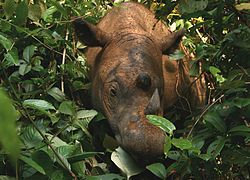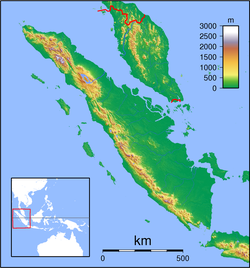Way Kambas National Park
| Way Kambas National Park | |
|---|---|
|
IUCN category II (national park)
|
|

Sumatran rhino in the Way Kambas Sanctuary
|
|
|
Location in Sumatra
|
|
| Location | Way Kanan Regency, Lampung, Sumatra, Indonesia |
| Nearest city | Bandar Lampung |
| Coordinates | 4°55′S 105°45′E / 4.917°S 105.750°ECoordinates: 4°55′S 105°45′E / 4.917°S 105.750°E |
| Area | 1,300 km2 (500 sq mi) |
| Established | 1989 |
| Visitors | 2,553 (in 2007) |
| Governing body | Ministry of Forestry |
Way Kambas National Park is a national park covering 1,300 square kilometres in Lampung province, southern Sumatra, Indonesia.
It consists of swamp forest and lowland rain forest, mostly of secondary growth as result of extensive logging in the 1960s and 1970s. Despite decreasing populations, the park still has a few critically endangered Sumatran tigers, Sumatran elephants and Sumatran rhinoceroses. It also provides excellent birdwatching, with the rare white-winged wood duck among the over 400 species present in the park.
Threats to the park are posed by poaching and habitat loss due to illegal logging. Conservation efforts include patrolling and the establishment of the Sumatran Rhino Sanctuary and the Elephant Conservation Centre.
In 2016, Way Kambas was formally declared an ASEAN Heritage Park.
Entrance fee for foreigners: 150 000IDR/day, 250 000 IDR at weekends. Camera fee: is 250 000 IDR/ year. Transport from Plang Ljo village entrance (loket) to Way Kanan 75 000IDR one way by motorbike. Accommodation in Way Kanan 250 000 IDR/ night without food and real toilet. Bird watching boat trip from Way Kanan ranger station 1 200 000IDR/boat it takes 2-3 hours. Not allowed to walk anywhere in the park without ranger. There is a 3km long overgrown trail, an easy walk, but cost 300 000IDR/guide.
Plant species include Avicennia marina, Sonneratia species, Nypa fruticans, Melaleuca leucadendra, Syzygium polyanthum, Pandanus species, Schima wallichii, Shorea species, Dipterocarpus gracilis, and Gonystylus bancanus. The sandy shores of the park are dominated by Casuarina equisetifolia.
...
Wikipedia

